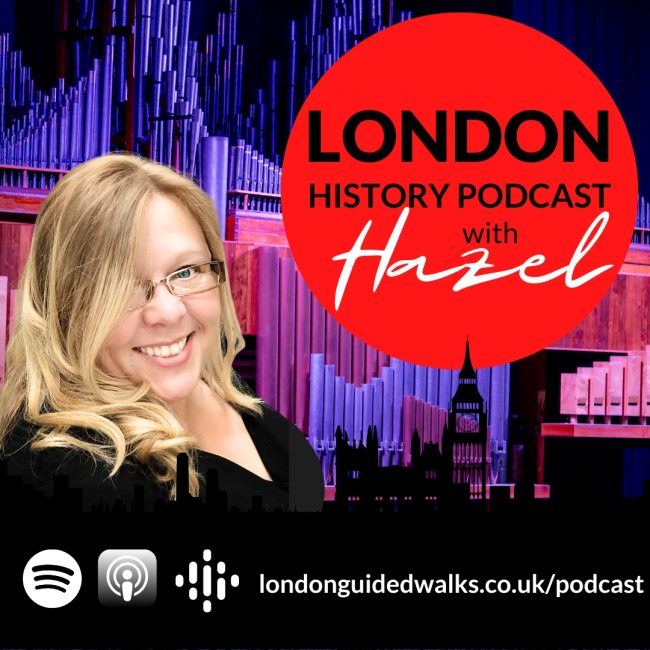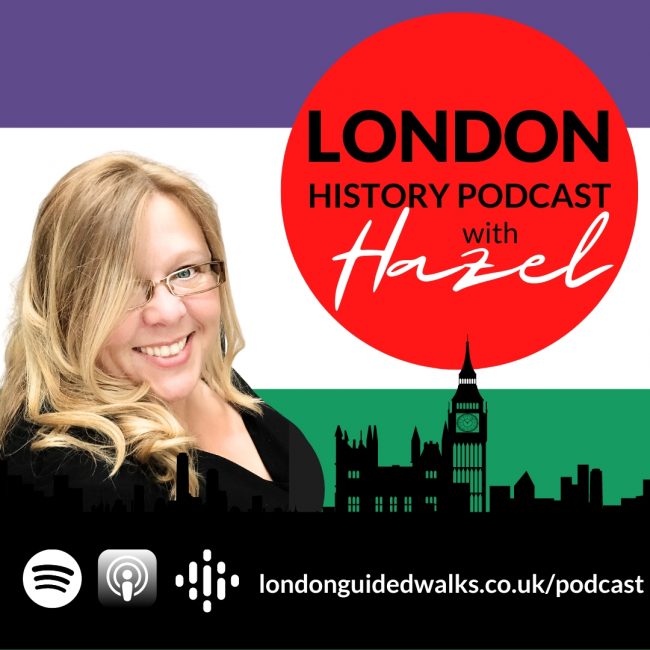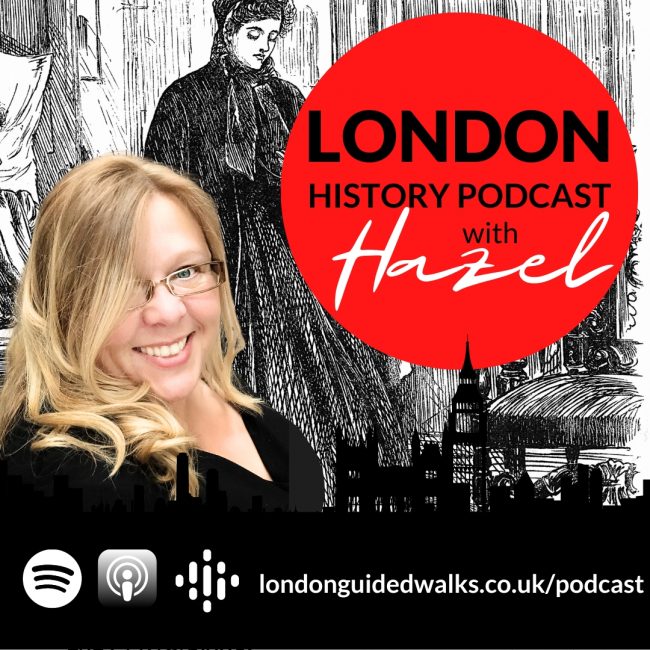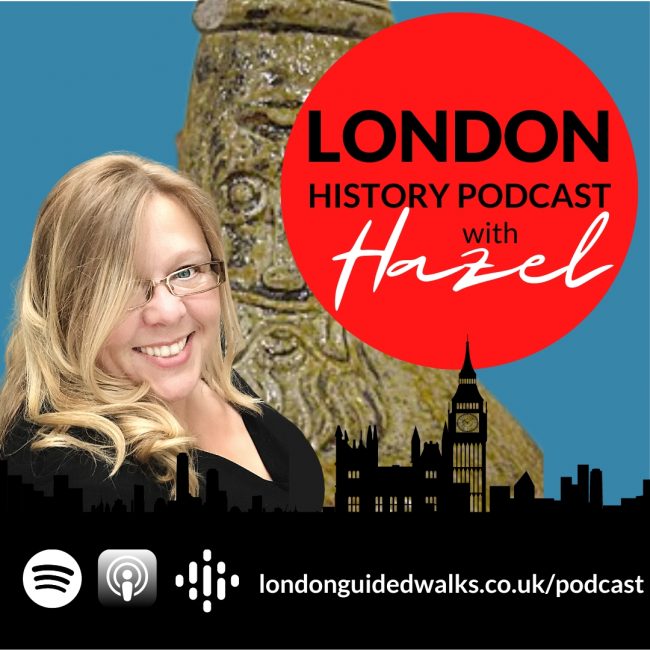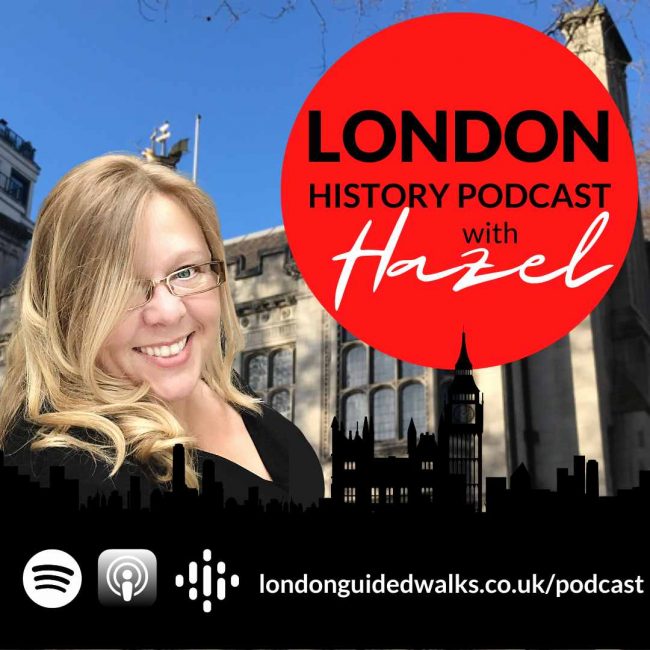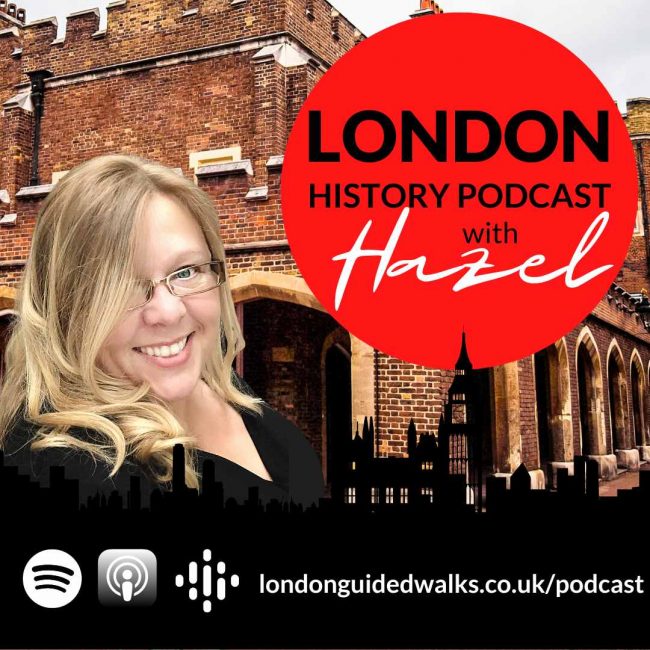London Area Names – Animal Edition
Recommended Reading:
Show Notes:
 Hazel Baker: Hello and welcome to London Guided Walks London History podcast. In the coming episodes, we will be sharing our love and passion for London, its people, places and history in an espresso shot with a splash of personality. For those of you who don’t know me, I am Hazel Baker, founder of London Guided Walks, providing guided walks and private tours to Londoners and visitors alike.
Hazel Baker: Hello and welcome to London Guided Walks London History podcast. In the coming episodes, we will be sharing our love and passion for London, its people, places and history in an espresso shot with a splash of personality. For those of you who don’t know me, I am Hazel Baker, founder of London Guided Walks, providing guided walks and private tours to Londoners and visitors alike.
To accompany this podcast we also have hundreds of London history blog posts for you to enjoy absolutely free. And also we’ve launched The Daily London, providing you with daily inspiration for things to do in London. You can listen on iTunes, Spotify, or even add it to your Alexa flash briefings, and you can check it all out on our website londonguidedwalks.co.uk/flash.
Joining me in the studio today is city of London tour guide Ian McDiarmid.
 Ian McDiarmid: Hello.
Ian McDiarmid: Hello.
Hazel Baker: And we’re going to be doing something a little bit different today, aren’t we?
Ian McDiarmid: Yeah, we’re going to be looking at names of London that are derived from animals.
Hazel Baker: Yeah, it’s something that’s really quite popular when we’re on our walks, isn’t it? People want to know about where a name comes from. So, it would be good to get to the bottom of some of them.
Ian McDiarmid: Yeah. But am I right in saying that there’s no hard and fast answers on this?
Hazel Baker: No, it’s funny, isn’t it? With language, it’s not like we have a lot of evidence of when names became the names that we know them now. It’s just how language has changed over time. But we’ll have a look and see what we can work out, whether we can actually believe the stories that have been told. The popular reasons for names coming into existence. And we can have a chat about it if you want.
Ian McDiarmid: Okay. Well, I drew up a list of names from places in London, which have this animal theme to them. So I’m going to pick them at random and throw them at you, Hazel, putting you on the spot. So are you ready for this? No pressure.
Hazel Baker: All right then go for it.
Ian McDiarmid: Okay, well, let’s begin with one I actually knew about, I think. Houndsditch.
Hazel Baker: Oh, okay. Yes. Well that one’s a 13th century name. Comes from the time where there was a ditch where people used to just throw their rubbish and it relates to the rubbish and dead dogs found in the ditch. Would you believe?
Ian McDiarmid: Yes and we should explain that it’s just an area immediately beyond the sissy war. In fact, it’s to the Northeast, isn’t it?
Hazel Baker: That’s right. Dumping ground. Yeah, absolutely. But did you know that in 1989, there was an excavation of this area of Houndsditch and they did find a number of dogs’ skeletons? Yeah. So maybe that, that this bit has a ring of truth to it after all.
Ian McDiarmid: Okay. Well now I’m going to pick another one from this list and I I’m guessing, I think, fairly safely here that we’re going to carry on this theme. The Isle of Dogs.
Hazel Baker: Yeah, that’s a good one. Isn’t it? I mean, people do say it was an area that wild dogs run around with. And it wasn’t a marshy wasteland, really. Now, Anton van den Wyngaerde, he did a Panorama of London in 1543, and that shows the area name as Isle of Dogs.
And we also know, later on Sammuel Pepys describes it as the unlucky Isle of Dogs. Now, while it was unlucky, I’m not quite sure, but several stories about it. So you’ve got like the wild dog story, but also don’t forget the Isle of Dog is just directly North of Greenwich. And Greenwich, had a hunting ground and a wonderful palace built by Henry the 8th and maybe he needed his dog’s house somewhere that wasn’t so, you know, away from the noise and the smell of the dogs, or maybe it was just on the other side of the River Thames. And maybe that’s where we get the name from.
Ian McDiarmid: Oh, okay. I remember that in the Maritime Museum or the Queen’s House where they’ve got lots of paintings of Greenwich, they often include the Isle of Dogs in the background. It’s interesting to see as somewhere that’s just completely empty, but I do sort of also remember, I think two or three windmills on the Western side of it, from those paintings.
Anyway, let’s go on, let’s ask you another one. I’m going to pick this one up cause it’s the same area. And so we’re moving away from the canine theme though. Canary Wharf. What’s the origin of that one, Hazel?
Hazel Baker: Yeah. So nothing to do with minors and canaries going down the mines. This one is related to the sea trade and of course the trade with the Canary islands. So from about 1802 to the early 1900s, Canary Wharf and the docks, there were some of the busiest stocks in the world.
Ian McDiarmid: Okay. Right. Good. Good, good. Good. Now we’ve spoken about dogs. What about Catford? How does that come to be named as Catford?
Hazel Baker: Well, this is a place, very popular place, Anglo Saxon times where the cattle would cross the river. So it’s a river Ravensbourne there and you’re thinking, okay, well, why wasn’t it called Cattlecross? But this is also a place where there are lots and lots of feral cats. So you can see the link of Isle of Dogs and Catford.
Also it’s believed, this is where a lot of black cats were actually drowned in the river when they were also hunting for witches because black cats are associated with witches.
Ian McDiarmid: Oh, that’s a bit depressing. Isn’t it?
Hazel Baker: Yeah, we weren’t nice to our animals.
Ian McDiarmid: No, no. I find stories of cruelty to cats bit sad. Anyway, we should explain that Catford is just near Lewisham isn’t it. South of Lewisham.
Hazel Baker: Yeah.
Ian McDiarmid: What about then Hazel, Ravenscourt Park?
Hazel Baker: Oh yeah. So Ravenscourt Park. Now there was in the 1600s, a Manor house bill 1650, actually. And then in 1747, so nearly coming down to a hundred years old. The house was bought by Thomas Corbett and he named it Ravenscourt. So what is Ravenscourt got to do with anything with Thomas Corbett? Well, ravens were in his coat of arms and Corbeau is raven in French. And of course we say Corbett, but I bet his original name was Thomas Corbeau. You know, making the link and putting his stamp on the history there.
Ian McDiarmid: Okay. And whereabouts is Ravenscourt?
Hazel Baker: West of Hammersmith.
Ian McDiarmid: Now Hammersmith is near Shepherd’s Bush. So what has Shepherd’s Bush got to do with animals?
Hazel Baker: Well, apart from in the name, we’re not, not quite sure. However, it is on that Western-Eastern road from the West coming into London and it’s believed this is where a lot of the sheep took a little break from their walk to their impending doom at Smithfield Market.
Ian McDiarmid: Hmm. I don’t think that many of these is going to be a happy stories, are they?
Hazel Baker: No, no. Well, don’t forget, you know, we didn’t have trains, we didn’t have all these at the time. So all these animals going to market in London would have had to walk there.
Ian McDiarmid: Yeah. what about. Now, we were talking about dogs earlier, what about the name Barking? Anything to do with dogs?
Hazel Baker: Barking huh Ian? Well, no. Nothing to do with dogs at all. We know that the name was Berecinges. And that’s an Anglo Saxon word, but we’re not quite sure on the meaning. There’s two options. One is that it’s a settlement of followers of descendants of a man called Berecca.
Or I like to say Berecca or it’s an area of Birch trees. And don’t forget, we have seven sisters, which are seven trees, so I’m kind of linking to the Birch trees, but that has moved into Barking as we know it now.
Ian McDiarmid: Okay. That’s fairly interesting. But if I’m being critical, that’s got absolutely nothing to do with animals, has it?
Hazel Baker: No, you’re right.
Ian McDiarmid: Okay. Moving on. What about Woolwich?
Hazel Baker: Yeah. So you’re talking Uulivich really. And that’s the old word for this area, which was known for trading in wool and wich. So you’ve got wool and then wich. And wich means just a landing place really. And don’t forget, you know, right by the river as well. So sheep would’ve probably come on ships.
Ian McDiarmid: Okay. Now another one was a sort of sheepy kind of name is Lambeth. Is that right? Is that to do with lamb?
Hazel Baker: Doing the Lambeth walk? You mean?
Ian McDiarmid: Yeah, that’s the one.
Hazel Baker: Yeah. So we have documentation of 1088 and it’s called, well I don’t have the transcript, but it’s like, sort of like Lamhytha.
So it’s L-A-M-H Y T H-A. So I say Lamhytha and that’s not too far from Lambeth. Now, don’t forget languages change in the way we pronounce, our words have changed quite a lot in that 1000 years. And it was basically a landing place for lambs!
Ian McDiarmid: Hmm.
Hazel Baker: So you have sheep in Woolwich and you have Lambs in Lambeth!
Ian McDiarmid: Okay. Now here’s one that doesn’t necessarily shout animals at you, but I think you’re going to tell me it is, Mayfair.
Hazel Baker: Yeah. What do you mean? He doesn’t shout animals at you?
Ian McDiarmid: Well it’s a fair held in may, I would guess.
Hazel Baker: Yeah. For sheep.
Ian McDiarmid: Okay.
Hazel Baker: Haha. So, I mean, it all goes down 1709 during the reign of Queen Anne, because she actually got quite a raucous affair.
So if you know where Shepard market is, ex-red light district? And this was where most of the fair was happening. There’d be gingerbread stores and lots of drinking, soldiers would come, girls would come with colourful ribbons in their hair. And the only happened the first two weeks of May. And it was given a Royal permission by James the 2nd.
And this was its new location before that it was on Haymarket. And that was a full time sheep and cattle market. And that would have been granted permission by Charles II in 1663 to the Earl of St. Albans. But that came so absolutely filthy and disgusting, they actually moved location.
Ian McDiarmid: Oh. What about Elephant and castle?
Hazel Baker: Yeah. So, this…
Ian McDiarmid: Oh, now, sorry me guess on this one. And I think I’m going to guess incorrectly, Pop Sign.
Hazel Baker: You’re just cheating now. Aren’t you?
Ian McDiarmid: Am I? No, I don’t know why I know that if it’s correct, but I think I do.
Hazel Baker: Well there’s two stories. One of them is the story of the cutlers. And their symbol, if you have a look at the Cutler’s Hall on, was it war Avenue in the city, they have a sign of an elephant and the castle.
Okay. No real link between the Cutlers and Elephant and Castle, as far as I’m aware. It’s really. Yes, pubs or coaching ends. Don’t forget pubs weren’t just places where you would sit and drink. These are places that you’d stay overnight or even fill it for weeks, depending on what you needed to do. There was no such thing as hotels.
Your taverns were the best places. And this was a pub that was really popular with ivory merchants in the 18th century. And it was on a very popular intersection of Old Kent Road and Newington Causeway, two main roads, both originally Roman roads. And that’s where the elephant in converged. So it just makes sense, this is where people are going to be coming together.
Ian McDiarmid: Hmm.
Hazel Baker: The Castle bit, I haven’t got a clue
Ian McDiarmid: So where, when they put on sandals on elephants in ancient times, it’s elephant and castle. That’s where it comes from.
Oh yeah, well, I remembered
This as well, and perhaps when they were fighting the British. Falconwood Park is in Bexley.
Hazel Baker: Yeah.
Ian McDiarmid: Well, I’m going to guess that’s got something to do with Falcons?
Hazel Baker: No, sorry to disappoint. So yeah, so it’s an area in Bexley. It was an area developed off a wood area, which would be known as Westward since 1551. And developers in the 1930s decided to develop the area and rename it, Falconward, to make it more attractive to residents.
And you see this across London Agamemnon way in West Hampstead, for example, was the worst area in West Hampstead to live, but rename it and suddenly it’s all very appealing.
Ian McDiarmid: Agamemnon sounds, that should be quite classy.
Hazel Baker: Yeah, they try.
Ian McDiarmid: Okay. Now Falconwood Park, maybe not a lot. We say it’s in Bexley. Maybe not a lot of people know Bexley. So let’s for the last one, go right into the centre of London and the name that may not be immediately apparent that it’s associated with animals. And that is Soho.
Hazel Baker: Yeah.
Ian McDiarmid: I know this one. So I can’t…but…
Hazel Baker: Are you going to tell everyone then?
Ian McDiarmid: Well, yeah. Okay. It’s to do with hunting, isn’t it?
Hazel Baker: What, you said you knew.
Ian McDiarmid: Well, I think it’s the cry that men on horses made when they were out hunting for little foxes. Is that right?
Hazel Baker: Well, yes, it’s through what men… But don’t forget, hunting was also accessible to some women, but Soho was their hunting cry, but not poor little Foxes, poor little hares.
So the name Soho first appears in the 17th century. So we’re talking 1600s and James Scott, who was the 1st Duke of Monmouth. He uses Soho as a rallying cry at the battle of Sedgemoor. And this is in 1685. And then this is a half a century after we’ve seen Soho being used for the name of this area.
Ian McDiarmid: Hmm. Okay, good.
Hazel Baker: So what’s next on your list?
Ian McDiarmid: I think we’ve gone through all of my little list. Ah, yeah. That’s all.
Hazel Baker: Well, I’m very disappointed, Ian.
Ian McDiarmid: Why?
Hazel Baker: Well, I know, you know, this one because you actually went to my walk!
Ian McDiarmid: Which is?
Hazel Baker: Vauxhall!
Ian McDiarmid: Vauxhall?
Hazel Baker: Yeah!
Ian McDiarmid: Okay. Go on.
Hazel Baker: Well, you said you were going to give me a list of places which had history of animal related names and you missed Vauxhall.
Ian McDiarmid: Okay. Hazel, I’ve got one for you. Vauxhall. What’s that got to do, now, I had no idea this had anything to do with animals at all. I would have assumed it was named after somebody called Vaux, go tell us.
Hazel Baker: Okay. So, Samuel Pepys is the reason why I know about this one because he talks in his diary, 1665 of getting on a boat and going to Fox hall is in F-O-X H-A-L-L.
And you go and one that could be anywhere! But he also talks about enjoying the gardens there and having very good conversations, civil conversations, and drink in the gardens. And of course we know from the 1740s, Vauxhall gardens is very popular. So I had a little look into this and Foxhall, indeed, it was called Foxhall all the way from 1216. So there was a chap called Folks Breute. And he married Margaret Fitzgerald. And, he was King John’s mercenary. And he was like one of the top dogs there. And he owned a large house in this area and people referred first of all to Folks’ hall.
And then as English not very good with foreign languages, got a bit complacent and called it Foxhall, and that is eventually moved into Vauxhall by the 1740s.
Ian McDiarmid: Hmm. Okay. Now I know an urban myth about Vauxhall. I say it’s a great story, but I’ve-
Hazel Baker: Is it clean?
Ian McDiarmid: It’s clean. I’m a bit reluctant to say it cause I’m fairly sure it’s a load of rubbish.
The story is dissolved visit was visiting. And I think we’re talking about Nicholas I and he’s on a train and they stop at what is Vauxhall station. And he leans out. He pulls the curtain back and he says to somebody what’s that meaning? What is this thing that we in English call the station and they said Vauxhall, and then the Russian word for station becomes Vauxhall.
It’s a great story. I’m fairly sure it’s a load of rubbish. That’s my contribution to Vauxhall.
Hazel Baker: I’m overwhelmed.
Ian McDiarmid: Yeah. You’re not looking overwhelmed at all. Okay. Well that was very interesting, Hazel. yeah, that’s good. So can we pursue this a bit further? Have we got other ideas up our sleeves for animal or other related names in London?
Yeah. Well, I was thinking maybe street names, cause that’s always rather interesting. Isn’t it? And people do ask when they’re on the walks, you know, what’s the origin of this street name? Why is it called this?
Will you be able to keep that one clean?
Hazel Baker: Well, I only can if you can.
Ian McDiarmid: Yeah. Okay. I’m just thinking medieval street names. Yeah.
Hazel Baker: So if anybody has a street name that they really want to get to the bottom of, and then send us a request via email, voice message on our website, text us or on Instagram or Twitter, we’re everywhere. So you’ll be able to find us and put in your request for London street names.
And we have had a request from Gita as well for the history of department stores. And, you know, I did that Mr. Selfridge and retail therapy talk many moons ago now. So this will be good to dive back into that, Ian.
Ian McDiarmid: Yeah, I like that. Well, you still do it don’t you?
Hazel Baker: Yeah. Just not as a public one, you know? I’ve got so many on the go. Gita, thank you very much for that one. We’ll be adding a podcast on that subject.
That’s all we’ve got time for now. Don’t forget. We have history related blog posts for this episode and others on all webpage londonguidedwalks.co.uk/podcast. Check out our Daily London, giving you daily inspiration for things to do in London.

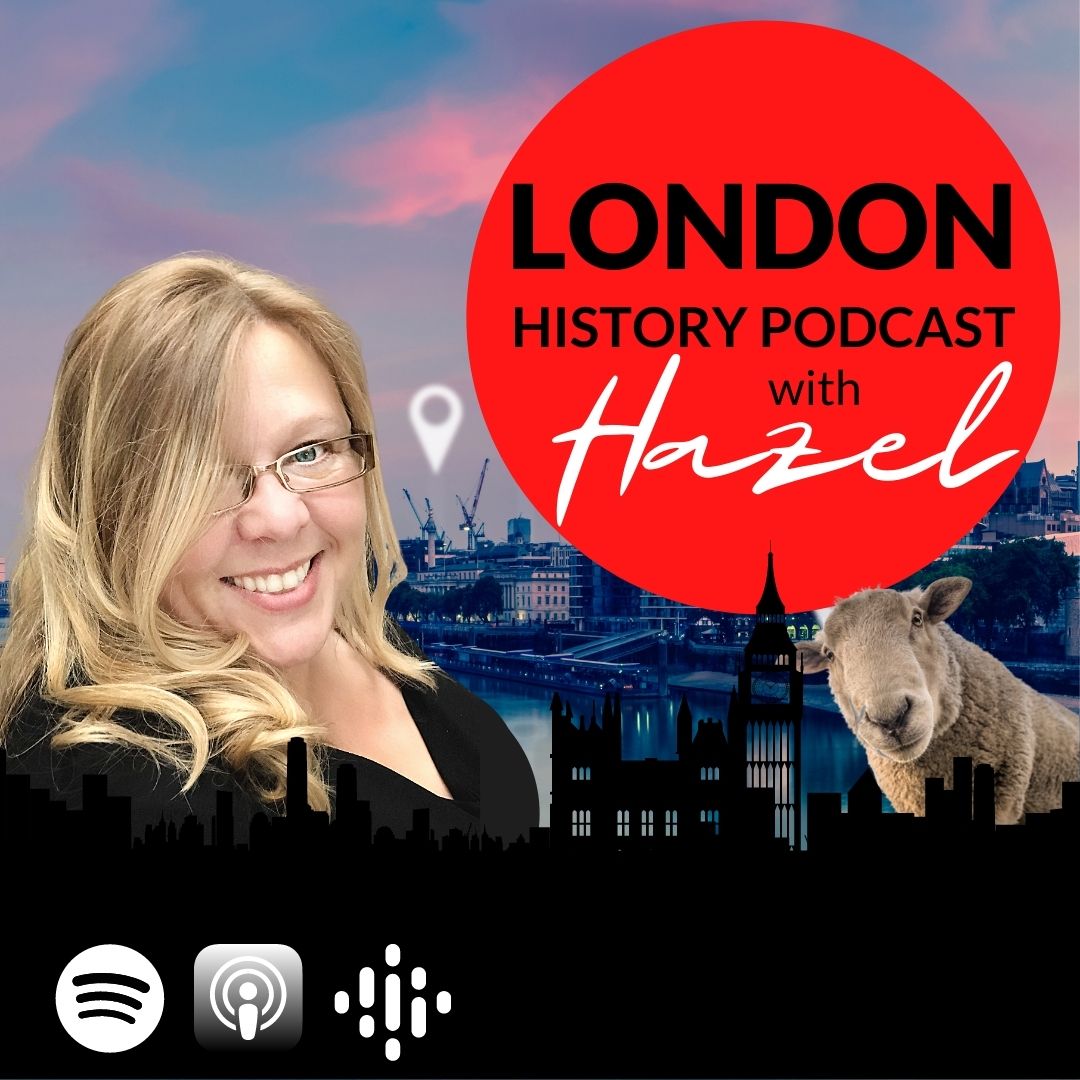
 Hazel Baker: Hello and welcome to London Guided Walks
Hazel Baker: Hello and welcome to London Guided Walks  Ian McDiarmid:
Ian McDiarmid: 